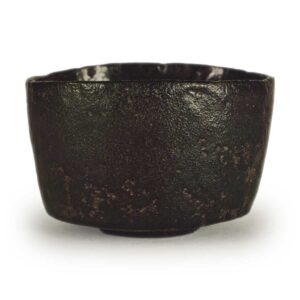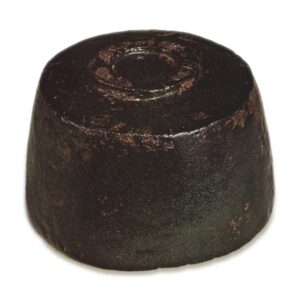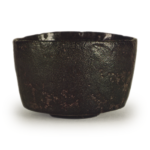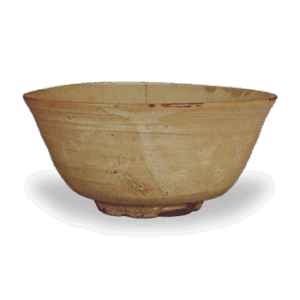

Height: 8.3-9.0cm
Diameter: 12.0-13.3cm
Outer diameter of foot ring: 5.2-5.5cm
Height at same point: 0.5cm
This is an unsigned tea bowl, but it is known as Koetsu Kuro (Koetsu Black) because it is a black tea bowl by Koetsu. At present, its origin is also largely unknown, but it is included in this book because it is a very outstanding tea bowl by Koetsu that was previously unknown.
The shape of the tea bowl is characteristic of Koetsu, with a distinct waistline, and it is a tea bowl that is part of a series of works that are similar to the Kaga Koetsu and Shichiri tea bowls, but it is not as richly decorated with vertical lines as the Kaga Koetsu, and it is most similar in style to the Shichiri tea bowls. The foot, which is almost completely vertical, is slightly low, and while the surface from the foot to the waist is slightly raised, the surface is very flat. From the waist to the mouth, it rises while opening outwards, with a slight bulge, and this shape can be said to be a typical Koetsu style.
The bottom of the interior is almost flat, with a slight dent in the center, but without a tea-drip well, and this too is characteristic of Koetsu. Furthermore, the rise from the interior bottom is a beveled angle, and the curve is exactly the same as that of the Shichiri.
What elevated this unadorned tea bowl to the same level as the famous bowls was the quality of the foot ring. I think that the most important point in identifying Koetsu tea bowls is the marks left by the scraping of the foot ring, and this bowl’s foot ring is truly characteristic of Koetsu, and although it is merely scraped out in a circular shape at random, it is full of a certain sense of power. The workmanship is slightly inferior to Shichiri, but superior to Kaga Koetsu.
Like the Amagumo and Shichiri, the surface is covered in a non-glazed black Raku glaze, but the firing temperature is quite high, and the glaze has a glossy sheen. However, the fact that there are many areas where the glaze has not fired properly is something it shares with the Shichiri and other pieces, and the unglazed areas have a texture reminiscent of iron. The foot ring with its five marks is also typical of Raku ware up to the Nongou period.
Although it is not particularly outstanding as a Koetsu tea bowl, it has a relaxed and dignified presence and a certain grandeur.
On the inside of the lid of the box, there is an inscription that reads “This tea bowl was donated by Hon’ami and came to our temple in the first year of the Meiwa era (1764). The person who donated it is called Dokuan, but we are still investigating which temple in the Daitokuji complex he was a priest at. The condition of the box and the inscription are both straightforward, which is very appealing, but because it was a temple treasure, the accompanying documents are quite simple.
Incidentally, a tea bowl that is very similar to this one is said to have been taken to America around the Meiji era, and can be seen in the collection of the Freer Gallery of Art.








